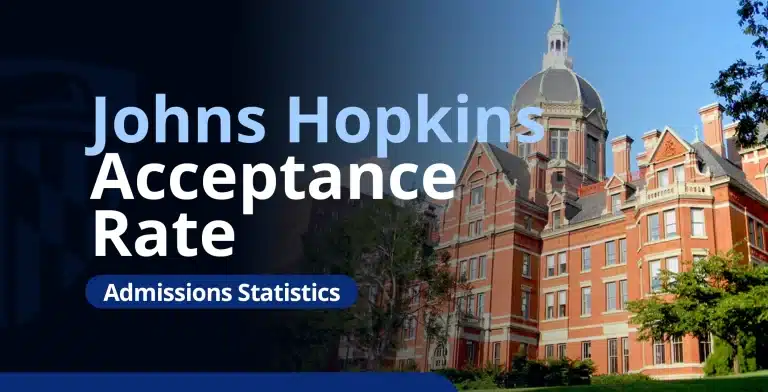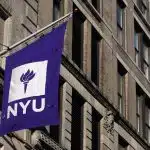Johns Hopkins has not yet officially released its overall acceptance rate for the Class of 2029. However, for the Class of 2028, the rate was just 5.7%, and it’s likely that the figure for the Class of 2029 will be similar or potentially even lower. This level of selectivity means only the strongest candidates are admitted. To earn a spot, your application must stand out in an exceptionally competitive pool.
But don’t stress! In this blog, we’ll break down what Johns Hopkins’ acceptance rate really means, how it has changed over time, and what you can do to improve your chances of getting in. Understanding Johns Hopkins’ admission stats can help you create a more strategic approach.
- What Is Johns Hopkins’s Acceptance Rate?
- Johns Hopkins Acceptance Rate Trends
- Johns Hopkins Regular Decision Acceptance Rate
- Johns Hopkins Early Action Acceptance Rate
- How to Get Accepted into Johns Hopkins
- Johns Hopkins Transfer Acceptance Rate
- Johns Hopkins Waitlist Acceptance Rate
- Frequently Asked Questions
- Takeaways
What Is Johns Hopkins’s Acceptance Rate?
For the Class of 2028, Johns Hopkins’s acceptance rate was just 5.77%. Out of 45,134 applicants, only 2,558 secured a spot. The striking contrast between these numbers just goes to show the high number of people you’ll be up against in their extremely challenging selection process.
Here’s a deeper dive into the numbers:
| Application Type | Total Applications | Accepted | Acceptance Rate |
| Regular Decision | TBA | 1,749 | TBA |
| Early Decision | TBA | 809 | TBA |
| Overall | 45,134 | 2,558 | 5.7% |
Johns Hopkins hasn’t released the full breakdown of Early Decision (ED) and Regular Decision (RD) data for the Class of 2028 yet, so we can’t compare them. But historically, Johns Hopkins’s ED acceptance rates have been higher than RD. For example, for the Class of 2027, the acceptance rate was 13.6% for ED and just 6.4% for RD. Still, let’s be real— even those “better” odds are insanely competitive.
Johns Hopkins’s yield rate
Another key metric Johns Hopkins monitors is its yield rate, which measures how many admitted students choose to enroll. For the Class of 2028, 1,288 students enrolled out of the 2,558 admitted, resulting in a 50.4% yield rate.
For context, the national average yield rate for four-year nonprofit colleges in fall 2022 was only 30%. Private colleges did slightly better at 33%, while public colleges were at 25%. With Johns Hopkins at 50.4%, it’s clear that top students really want to be there.
This high yield rate highlights the university’s ability to attract students who are genuinely eager to be part of its community. It’s also one of the ways Johns Hopkins maintains its highly selective admissions process while ensuring each incoming class is filled with motivated and committed students.
Johns Hopkins Acceptance Rate Trends
Johns Hopkins’ acceptance rate has been steadily plummeting over the past few years. Let’s look at the recent numbers:
| Johns Hopkins Class | Total Applications | Overall Acceptance Rate |
| 2028 | 45,134 | 5.7% |
| 2027 | 38,926 | 7.6% |
| 2026 | 37,844 | 7.3% |
| 2025 | 39,515 | 7.5% |
| 2024 | 29,612 | 8.8% |
The bottom line? Securing an acceptance letter is tougher than ever. Applications have surged, especially since Johns Hopkins adopted a test-optional policy during the pandemic. For the Class of 2028, submissions exceeded 45,134, driven in part by students hoping that omitting SAT/ACT scores might boost their chances.
But it’s not just the number of applications causing the drop in acceptance rates. Johns Hopkins has kept its class size small and selective, even as more and more students try their luck. They’re still focused on finding those well-rounded applicants—not just the ones with perfect grades and test scores, but those with standout extracurriculars, leadership, and unique stories.
The message is clear: with acceptance rates getting tighter each year, strong academics won’t be enough. To cut through the noise, you’ve got to bring something extra to the table.
Johns Hopkins’s acceptance rate vs other Ivy League schools
Comparing Johns Hopkins’s acceptance rate to those of Ivy League schools gives us a better sense of just how competitive it really is. Here’s how Johns Hopkins stacks up against its peers:
| Ivy League School | Acceptance Rate (Class of 2028) |
| Harvard University | 3.6% |
| Yale University | 3.7% |
| Columbia University | 3.85% |
| Princeton University | 4.6% |
| Brown University | 5.2% |
| University of Pennsylvania | 5.3% |
| Cornell University | 5.4% |
| Dartmouth College | 8.4% |
As you can see, schools like Harvard (3.6%) and Yale (3.7%) are more selective, while Cornell (8.4%) is slightly less competitive. But Johns Hopkins (5.7%) is just about as competitive as Brown (5.2%), UPenn (5.3%), and Cornell (5.4%).
One factor that plays into these numbers is the size of the applicant pool. Schools like Harvard receive over 50,000 applications, which drives their acceptance rates lower. Johns Hopkins may have a slightly higher acceptance rate because of its smaller applicant pool.
Johns Hopkins stands out for its unique balance of exclusivity and accessibility. While its acceptance rate might be marginally higher than some Ivy League schools, gaining admission is far from easy. If you’re aiming for Johns Hopkins, you’ll need an exceptional application to shine in such a highly competitive environment.
Johns Hopkins Regular Decision Acceptance Rate
Johns Hopkins’ Regular Decision (RD) acceptance rate for the Class of 2028 hasn’t been released yet. For the Class of 2027, though, it was 6.4%. Out of 32,660 RD applicants, only 2,090 got in.
So, why is RD typically harder to get into? A big reason is Johns Hopkins’s Early Decision (ED) program, which fills a large chunk of the incoming class. With an ED acceptance rate of 13.6% for the Class of 2027, early applicants definitely have an advantage, leaving fewer spots for those applying through RD.
The trend is not looking easier anytime soon. Just check the numbers:
| Johns Hopkins Class | Total Regular Decision Applications | Regular Decision Acceptance Rate |
| 2028 | TBA | TBA |
| 2027 | 32,660 | 6.4% |
| 2026 | 32,190 | 5.9% |
| 2025 | 33,982 | 6.2% |
In recent years, Johns Hopkins’ Regular Decision acceptance rate has stayed around a tight 6%. Johns Hopkins’ growing popularity, coupled with its commitment to maintaining a small and highly selective class size, continues to make the admissions process highly competitive.
If you’re aiming for a spot through Regular Decision, keep in mind that exceptional grades are just the baseline. To truly stand out, you’ll need to craft compelling essays, demonstrate impressive extracurricular achievements, and secure glowing recommendation letters.
Johns Hopkins Regular Decision deadline and notification date
Johns Hopkins’s RD deadline is January 1, and they usually release decisions in late March. After that, you’ve got until May 1, which is College Decision Day, to send in your confirmation.
Johns Hopkins Early Decision Acceptance Rate
Just like its Regular Decision (RD) stats, Johns Hopkins hasn’t released the specific Early Decision (ED) data for the Class of 2028 yet. However, we do have the numbers for the Class of 2027: out of 6,266 applicants, only 853 were accepted, resulting in an ED acceptance rate of 13.6%.
When you compare that to the corresponding RD rate of 6.4%, one thing is clear: applying early can significantly improve your chances. Johns Hopkins prioritizes securing a substantial portion of its freshman class through ED, favoring students who demonstrate a strong commitment to joining their community.
Let’s take a look at Johns Hopkins’s ED acceptance rates in recent years:
| Johns Hopkins Class | Total Early Decision Applications | Early Decision Acceptance Rate |
| 2028 | TBA | TBA |
| 2027 | 6,266 | 13.6% |
| 2026 | 5,654 | 14.8% |
| 2025 | 5,533 | 15.3% |
Johns Hopkins ED acceptance rate has been slowly dropping, from 15.3% for the Class of 2025 to 13.6% for the Class of 2027. Meanwhile, the number of ED applicants keeps going up, meaning more students are trying to get in early, making it even tougher. If this trend continues, the Class of 2028 will probably see an even lower ED acceptance rate.
Still, Johns Hopkins is more likely to admit students who apply early and make a strong impression. But keep in mind, the ED pool is packed with top-tier applicants—strong academics, impressive extracurriculars, and standout essays. So if you’re applying early, you’ve got to bring your A-game.
Take note: ED at Johns Hopkins is binding. This means that if you’re admitted, you’re committed to attending. This pathway is typically for students who have Johns Hopkins as their absolute first choice, which can make a strong impression on admissions officers evaluating your application.
If you apply through ED, you’ll know months ahead of the RD folks whether you’re in, which can seriously cut down on stress and let you plan your next steps. Don’t rush it just to meet the early deadline, though. You’ve got to be sure your application is the best it can be. If you’re not quite there yet, it might make more sense to take the extra time and aim for RD.
Johns Hopkins Early Decision deadline and notification date
Johns Hopkins ED’s deadline is November 1, and they typically send out notifications by mid-December. If you’re accepted, you still have until May 1 to confirm your spot.
How to Get Accepted into Johns Hopkins
So, you’ve set your sights on Johns Hopkins? First things first—you need to get that application in through either the Common or Coalition Application.
But don’t think it’s just about getting your forms in on time. Johns Hopkins takes a good, long look at your whole application, assessing you from every angle. Sure, grades and test scores play a big part, but the admissions committee also wants to see essays that are thoughtful, extracurriculars that show passion, and recommendation letters that actually say something about who you are.
Let’s dig into a few key areas that could boost your chances of beating the Johns Hopkins acceptance rate:
Target GPA
While Johns Hopkins doesn’t outright say, “Here’s the GPA you need,” let’s be real: you’re up against some pretty fierce competition.
According to Johns Hopkins’s Common Data Set for 2023-2024, the average GPA for admitted students is an impressive 3.95 on a weighted scale. This shows that most successful applicants not only excel in their standard coursework but also take on advanced classes like AP or IB to further boost their GPAs.
Aiming for a GPA of 3.95 or higher will align you with the typical Johns Hopkins admit, demonstrating that you have been a top performer throughout high school. If your GPA is slightly lower, don’t worry. Instead, focus on highlighting other standout aspects of your application to grab the admissions committee’s attention.
Target test scores
The story is similar when it comes to test scores. While Johns Hopkins doesn’t set a specific cutoff, you’ll need outstanding scores to stand out. The latest numbers are quite competitive:
| Standardized Test | 25th Percentile Score | 50th Percentile Score | 75th Percentile Score |
| SAT | 1530 | 1550 | 1560 |
| ACT | 34 | 35 | 35 |
To strengthen your chances of admission, aiming for a SAT score of 1560 or higher is ideal. For the ACT, aiming for a 35 will place you among the top-tier applicants.
Important note: Johns Hopkins is currently test-optional for Fall 2025, but they’ll be reinstating standardized testing requirements starting with Fall 2026 and beyond.
Other requirements
Beyond your GPA and test scores, Johns Hopkins wants to see the whole you. That’s why the other parts of your application—extracurriculars, essays, and recommendation letters—matter just as much (if not more).
- Extracurriculars. Johns Hopkins is looking for activities that show real passion, commitment, and impact. Quality over quantity. It’s more impressive if you’ve been deeply involved in a few meaningful projects—like leading an organization, starting a community initiative, or even gaining some national recognition in your field.
- Essays. This is where you can truly shine. For the 2024-25 application cycle, you’ll need to write one personal statement (through the Common App or Coalition App) and then tackle five supplemental essays, each limited to 150 words. Think of these essays as your chance to let Johns Hopkins in on who you really are. Authenticity is key here.
- Recommendation letters. Johns Hopkins wants three: two from teachers who know you well and one from your school counselor. Strong letters can really give you an edge, so it’s worth investing time in building solid relationships with your recommenders. Ideally, pick teachers who can vouch for your intellectual curiosity, perseverance, and overall vibe in the classroom.
If you’re looking for a deeper dive into each of these sections, check out our guide that breaks down every requirement step-by-step. It’ll help you craft an application that can give you the best shot at cracking that elusive Johns Hopkins acceptance rate.
Johns Hopkins Transfer Acceptance Rate
According to Johns Hopkins’s Common Data Set for 2023-2024, the transfer acceptance rate is 15.7%. Out of 1,847 students, only 118 were admitted—and just 55 of them actually enrolled. For full details on requirements and deadlines, visit the Johns Hopkins Transfer Admissions page.
Why is it so hard to transfer to Johns Hopkins? It’s partly because Johns Hopkins’s incoming classes are already packed. The vast majority of seats are taken up by incoming freshmen, leaving only a handful of spots for transfer students.
And unlike freshman admissions, which balance academics with extracurriculars and potential, the transfer process is more focused. Johns Hopkins wants to see that your academic journey so far aligns with what they offer. You’ll need to show not just top-tier grades, but a clear reason why making the switch to Johns Hopkins makes sense for you.
Johns Hopkins’s also on the lookout for transfer students who bring something fresh to the table—new perspectives or experiences that can enrich their campus community. The bar’s set even higher because, let’s face it, most transfer applicants are already doing great at other top schools.
If you’re hoping to break through that Johns Hopkins acceptance rate, you’ll need to prove you’re exceptional. That means showing stellar academics, a compelling reason for wanting to transfer, and clear evidence that you can handle the intensity of Johns Hopkins’s academic environment.
Johns Hopkins Waitlist Acceptance Rate
According to their Common Data Set for 2023-2024 (Class of 2027), Johns Hopkins waitlisted 2,478 students. Out of the 1,748 who confirmed their waitlist spots, only 71 got admitted. That’s a waitlist acceptance rate of 4.1%.
Johns Hopkins University’s waitlist acceptance rate can vary annually based on available spaces and class composition needs. For instance, in 2022, the university offered 3,443 students a place on the waitlist, but nobody got in. The reality is that the chances of getting off the waitlist are unpredictable.
What to do if you’re waitlisted
Being waitlisted at Johns Hopkins basically means the admissions team liked your application, but they just didn’t have room to offer you a spot at the time. So, they put you on hold. You were definitely a strong contender, but since their class was almost full, you ended up on the waitlist.
If you find yourself on the waitlist, here’s what you can do to nudge your chances (however slim) in the right direction:
- First, confirm your spot. Officially accept your spot by following Johns Hopkins’s instructions.
- Next, write a Letter of Continued Interest (LOCI). Let Johns Hopkins know they’re still your top choice and fill them in on any cool things you’ve done since you first applied—awards, new projects, whatever. This shows them you’re still committed and excited to attend.
- If Johns Hopkins allows it, consider sending in some extra materials. Think updated transcripts, improved test scores, or even another recommendation letter. But only if these new additions really boost your profile.
- Finally, don’t put all your eggs in one basket. Sure, it’s okay to keep hoping, but be realistic too. Make sure you’ve got a spot locked down at another school where you’ve been accepted. The waitlist game is unpredictable, so having a solid backup plan is just smart.
In the end, being on Johns Hopkins’s waitlist is a tricky spot. Staying proactive can help, but you’ve also got to keep your options open and your expectations in check.
Frequently Asked Questions
1. What is Johns Hopkins’s latest overall acceptance rate?
For the Class of 2028, the Johns Hopkins acceptance rate was at 5.7%. Out of 45,134 applicants, only 2,558 were offered a slot.
2. What is Johns Hopkins’s Early Decision acceptance rate?
During the ED round for the Class of 2028, Johns Hopkins accepted 809 students but did not disclose the total number of applicants. For the Class of 2027, though, their ED acceptance rate was 13.6%.
3. What is Johns Hopkins’s Regular Decision acceptance rate?
In the RD cycle for the Class of 2028, Johns Hopkins accepted just 1,749 applicants but did not disclose the total number of applicants. But for the Class of 2027, their RD acceptance rate was 6.4%.
4. What is Johns Hopkins’s transfer acceptance rate?
For the Class of 2027, the Johns Hopkins acceptance rate for transfers was at 15.7%. Out of 1,847 hopefuls, only 118 were accepted.
5. What is Johns Hopkins’s waitlist acceptance rate?
Johns Hopkins’ waitlist acceptance rate is around 4.1%, but it changes every year based on available spots and the makeup of the incoming class.
Takeaways
To really get a grip on the Johns Hopkins acceptance rate and boost your chances, here are five key things you should know:
- Johns Hopkins’s latest overall acceptance rate is just 5.7%. It’s one of the toughest schools to get into.
- Its acceptance rate is comparable to Ivy League schools. Cornell, for example, has a rate of about 8.4%, putting it not far from Johns Hopkins’s.
- Johns Hopkins has not released the Early Decision acceptance rate for the Class of 2028, but 809 students were admitted through ED. In contrast, 1,749 were accepted via Regular Decision, showing the potential advantage of applying early. For the Class of 2027, the ED acceptance rate was 13.6%, while RD was significantly lower at 6.4%, reinforcing why Early Decision can be a smart move.
- If you want to be seriously competitive, you’re looking at a GPA of 3.9 or higher. For test scores, aim for at least a 1560 on the SAT and a perfect 35 on the ACT. But don’t stop there: nailing your essays, extracurriculars, and recommendation letters is just as important.
- With such a low acceptance rate, it might be worth getting some expert help. Working with a college admissions consultant could give your Johns Hopkins application that extra edge you need to stand out.

Eric Eng
About the author
Eric Eng, the Founder and CEO of AdmissionSight, graduated with a BA from Princeton University and has one of the highest track records in the industry of placing students into Ivy League schools and top 10 universities. He has been featured on the US News & World Report for his insights on college admissions.










